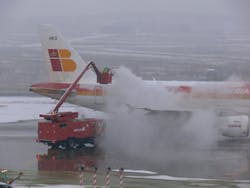Winter's Worst
We’re wrapping up our June/July issue in the middle of June and what’s the focus? Deicing. Perfect! Just as my mom picked up a bargain on a winter coat for me in August back in my grade school days, many of our readers are preparing for the winter ahead at this point in the year.
Maybe it’s the Midwestern in me, but I’d rather soon forget last winter. If I remember right (and I’d rather not) the surface of Mars was warmer than Northern Minnesota. Sure enough, Google tells me International Falls, MN, reported 40 below in January while the Mars rover beamed back a relatively balmy 26 below that same day. In other words, a spot on a planet 140 million miles further from the Sun than we are was in better shape.
Come to think of it, it probably isn’t just the Midwestern in me that doesn’t want to think about the winter months ahead. Subfreezing temperatures reached all the way into Deep South Texas, central Florida and many areas along the Gulf Coast.
RECORD BAD
But take heart. Can this winter be so bad? Aren’t the odds with us? As a recent AP story summed up, this past winter was the worst for fliers in the 20 years that the government has been collecting data.
During the first three months of this year, U.S. airlines canceled 4.6 percent of their flights, according to the Department of Transportation figures. The worst winter before this was 2001. See there? I figure we're in for a 13-year respite.
“Mother Nature is mostly to blame, with a relentless wave of snow and ice storms paralyzing airline traffic across the nation,” the story said.
Still, the story also points out the sometimes unintended consequences of even the most well-intentioned regulation.
No matter what this winter may bring for deicing operations, for example, airlines are much more prone to cancel flights, sometimes a day in advance of a storm.
In May 2010, a new DOT rule took effect prohibiting airlines from keeping passengers on the tarmac for three hours or more. This winter, airlines chose to cancel blocks of flights to avoid potential fines of up to $27,500 per passenger or $4.1 million for a typical plane holding 150 fliers. Additionally, the government implemented a new rule on New Year's Day, increasing the amount of rest pilots need. That made it harder to operate an irregular schedule, such as those seen after a storm. In order to have enough well-rested pilots, airlines cancel more flights.
In March, as a result, JetBlue had the highest cancellation rate among the bigger airlines with 2 percent of flights. That was closely followed by the merged American Airlines and US Airways, canceling 1.9 percent. Southwest Airlines and United Airlines both canceled 1.1 percent and Delta Air Lines 0.2 percent.
Some of the highest flight cancellation numbers, however, came from smaller regional airlines that are operated by other companies on behalf of the major airlines. ExpressJet, which flies regional planes for American, Delta and United, scrapped 5.1 percent of its March flights. American Eagle canceled 4.1 percent of its flights and SkyWest nixed 2.3 percent of its scheduled flights.
The airlines do lose money by canceling flights when stranded travelers demand refunds. United recently said that early January storms cost it $80 million in lost revenue.
But the sting isn't as bad as you might think.
Jim Corridore, an airline analyst with S&P Capital IQ, noted in article that United also saved millions in fuel and salaries by not having to fly the canceled flights. And some level of storm-related expenses is already built into airline budgets.
"We're not going to have this type of winter, every winter," Corridore says.
We’ll second that thought.
